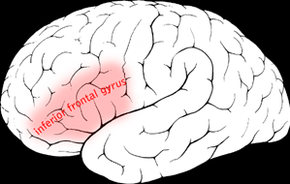Broca's area
|
Brain: Broca's area | |
|
| |
|
Broca's area visible but not labeled. |
|
|
Part of |
Frontal lobe |
|
Artery |
Middle cerebral |
|
Vein |
Superior sagittal sinus |
|
NeuroNames |
ancil-251 |
Broca's area is a section of the human brain that is involved in language processing, speech or sign production, and comprehension. Broca's area is named after the 19th-century physician Paul Broca. The concept of Broca's Area was originally produced with the intent to explain how speech production was inhibited in the learning of communication by the deaf; however, it is currently used to describe many anatomical aspects of psychological processing mechanisms.
Description
Broca's area is located in the opercular and triangular sections of the inferior frontal gyrus of the frontal lobe of the cortex. Broca's and Wernicke's areas are found unilaterally in the brain (dominant hemisphere, usually left hemisphere). It is supplied by the superior division of the Left Middle Cerebral Artery.
Broca's area comprises Brodmann area and (according to some authorities) Brodmann area Broca's Area is connected to Wernicke's area by a neural pathway called the arcuate fasciculus. The corresponding area in macaque monkeys is responsible for high-level control over orofacial actions.
Parts
Broca's area has two main parts, which express different roles during language comprehension and production:
• Pars triangularis (anterior), which is thought to support the interpretation of various 'modes' of stimuli (plurimodal association) and the programming of verbal conducts
• Pars opercularis (posterior), which is thought to support the management of only one kind of stimulus (unimodal association) and the coordination of the speech organs for the actual production of language, given its favorable position close to motor-related areas
Aphasia
People suffering from damage to this area may show a condition called Broca's aphasia (sometimes known as expressive aphasia, motor aphasia, or nonfluent aphasia), which makes them unable to create grammatically-complex sentences: It's often described as telegraphic speech and contains little but content words. Patients are usually aware that they cannot speak properly. Comprehension in Broca's aphasia is relatively normal, although many studies have demonstrated that Broca's aphasics have trouble understanding certain kinds of syntactically-complex sentences.
For example, in the following passage, a Broca's aphasic patient is trying to explain how he came to the hospital for dental surgery:
"Yes... ah... Monday... er... Dad and Peter H...and Dad.... er... hospital... and ah... Wednesday... Wednesday, nine o'clock... and oh... Thursday... ten o'clock, ah doctors... two... an' doctors... and er... teeth... yah."
This type of aphasia can be contrasted with Wernicke's aphasia, named for Carl Wernicke, which is characterized by damage to more posterior regions of the left hemisphere in the superior temporal lobe. Wernicke's aphasia manifests as a more pronounced impairment in comprehension. Because speech production retains a natural-sounding rhythm, and remains relatively normal grammatically, it is nonetheless often roundabout, vague, or meaningless. It is therefore also known as receptive aphasia.
Positron emission tomography (PET) and functional magnetic resonance imaging (fMRI) have found decreases in activity in the Broca's area in stuttering. There is greater activation of the right hemisphere homologue of the Broca's area (area of Ross), which is believed to be a compensatory response to the hypoactivity in the Broca's area proper. Volumetric magnetic resonance imaging (VMRI) has shown that the pars triangularis is smaller in people that stutter.
Evolution of human language
Broca's area is considered a marker for the development of language in the evolution of humans. The paleontological record of species leading to modern humans, Homo sapiens, finds that this part of the neural structure of the brain is present in fossils of Homo sapiens, and of Homo habilis, whereas the presumed precursors of these early humanoids, australopithecines, lacked this area of the brain (note that this information depends on the analysis of skulls where the presence of Broca's area can be determined).
Whereas Broca's area is unique in its linguistic role to humans, it is present in animals, although it performs other similar roles that were adapted to language in humans.
The fossil record cannot, of course, give firm data about the beginning of language, which is one of the critical factors contributing to the evolution of Homo sapiens into the species that we have become. However, the association of Broca's area with language in modern man may guide further analysis of this evolution.

